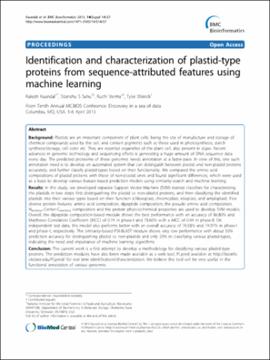| dc.contributor.author | Kaundal, Rakesh | |
| dc.contributor.author | Sahu, Sitanshu S. | |
| dc.contributor.author | Verma, Ruchi | |
| dc.contributor.author | Weirick, Tyler | |
| dc.date.accessioned | 2018-11-09T21:10:45Z | |
| dc.date.available | 2018-11-09T21:10:45Z | |
| dc.date.issued | 2013-10-09 | |
| dc.identifier | oksd_kaundal_identificationa_2013 | |
| dc.identifier.citation | Kaundal, R., Sahu, S. S., Verma, R., & Weirick, T. (2013). Identification and characterization of plastid-type proteins from sequence-attributed features using machine learning. BMC Bioinformatics, 14(Suppl 14), Article S7. https://doi.org/10.1186/1471-2105-14-S14-S7 | |
| dc.identifier.uri | https://hdl.handle.net/11244/302052 | |
| dc.description.abstract | Background: Plastids are an important component of plant cells, being the site of manufacture and storage of chemical compounds used by the cell, and contain pigments such as those used in photosynthesis, starch synthesis/storage, cell color etc. They are essential organelles of the plant cell, also present in algae. Recent advances in genomic technology and sequencing efforts is generating a huge amount of DNA sequence data every day. The predicted proteome of these genomes needs annotation at a faster pace. In view of this, one such annotation need is to develop an automated system that can distinguish between plastid and non-plastid proteins accurately, and further classify plastid-types based on their functionality. We compared the amino acid compositions of plastid proteins with those of non-plastid ones and found significant differences, which were used as a basis to develop various feature-based prediction models using similarity-search and machine learning. | |
| dc.description.abstract | Results: In this study, we developed separate Support Vector Machine (SVM) trained classifiers for characterizing the plastids in two steps: first distinguishing the plastid vs. non-plastid proteins, and then classifying the identified plastids into their various types based on their function (chloroplast, chromoplast, etioplast, and amyloplast). Five diverse protein features: amino acid composition, dipeptide composition, the pseudo amino acid composition, Nterminal-Center-Cterminal composition and the protein physicochemical properties are used to develop SVM models. Overall, the dipeptide composition-based module shows the best performance with an accuracy of 86.80% and Matthews Correlation Coefficient (MCC) of 0.74 in phase-I and 78.60% with a MCC of 0.44 in phase-II. On independent test data, this model also performs better with an overall accuracy of 76.58% and 74.97% in phase-I and phase-II, respectively. The similarity-based PSI-BLAST module shows very low performance with about 50% prediction accuracy for distinguishing plastid vs. non-plastids and only 20% in classifying various plastid-types, indicating the need and importance of machine learning algorithms. | |
| dc.description.abstract | Conclusion: The current work is a first attempt to develop a methodology for classifying various plastid-type proteins. The prediction modules have also been made available as a web tool, PLpred available at http://bioinfo.okstate.edu/PLpred/ for real time identification/characterization. We believe this tool will be very useful in the functional annotation of various genomes. | |
| dc.format | application/pdf | |
| dc.language | en_US | |
| dc.publisher | BioMed Central | |
| dc.rights | This material has been previously published. In the Oklahoma State University Library's institutional repository this version is made available through the open access principles and the terms of agreement/consent between the author(s) and the publisher. The permission policy on the use, reproduction or distribution of the material falls under fair use for educational, scholarship, and research purposes. Contact Digital Resources and Discovery Services at lib-dls@okstate.edu or 405-744-9161 for further information. | |
| dc.title | Identification and characterization of plastid-type proteins from sequence-attributed features using machine learning | |
| osu.filename | oksd_kaundal_identificationa_2013.pdf | |
| dc.description.peerreview | Peer reviewed | |
| dc.identifier.doi | 10.1186/1471-2105-14-S14-S7 | |
| dc.description.department | National Institute for Microbial Forensics and Food and Agricultural Biosecurity | |
| dc.description.department | Biochemistry and Molecular Biology | |
| dc.type.genre | Article | |
| dc.type.material | Text | |
| dc.subject.keywords | support vector machine | |
| dc.subject.keywords | receiver operating characteristic curve | |
| dc.subject.keywords | amino acid composition | |
| dc.subject.keywords | area under curve | |
| dc.subject.keywords | matthews correlation coefficient | |
